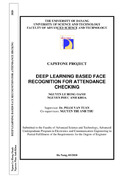
Please use this identifier to cite or link to this item:
http://thuvienso.dut.udn.vn/handle/DUT/4117| DC Field | Value | Language |
|---|---|---|
| dc.contributor.advisor | Pham, Van Tuan, Dr. | |
| dc.contributor.author | Nguyen, Le Kieu Oanh | |
| dc.contributor.author | Nguyen, Phuc Anh Khoa | |
| dc.date.accessioned | 2024-11-06T05:20:10Z | - |
| dc.date.available | 2024-11-06T05:20:10Z | - |
| dc.date.issued | 2020 | |
| dc.identifier.uri | http://thuvienso.dut.udn.vn/handle/DUT/4117 | - |
| dc.description | DA.FA.20.020 ; 62 p. | vi |
| dc.description.abstract | Being watched and/or monitored is a legitimate fear for many people. This is why facial recognition is slowly to be accepted and welcomed in society. One industry or field of work that would benefit the most out of facial recognition though, is that of attendance systems. The applications of Face Recognition Based Attendance System could be considered to be an important tool for various institutions such as school, college and university. Depend on the uniqueness of an individual is in his/her face. In this system, human face is used for marking the attendance automatically. Traditional checking attendance method requires calling outloud the name or roll number of students in order to record attendance. This process consumes a lot of time for a lecture that lasts about 60 minutes. To stay away from such losses, an automatic checking attendance process is used in this project which is based on Face Recognition technique. In this project, we built and set up a complete automatic attendance system including Face Recognition module and Web Application for management, and we also built a face dataset of students in the FAST department. In Face Recognition technique, facial detection and recognition was used. Face detection is used to locate the position of face region and face recognition is used for marking the understudy’s attendance. The dataset of students in the class is stored and when the face of an individual student matches with one of the faces stored in the dataset then his/her attendance is recorded. The major steps in our proposal recognition module are detecting the faces, aligning the face from cropped images, representing the face features by FaceNet model, classifying the features with Support Vector Machine. Four different face detection methods which are Haar-cascades, Histogram of Oriented Gradients and Support Vector, Convolutional Neural Networks, Multi- task Cascaded Convolutional Networks have been tested with the UTK face dataset for examining negative impacts of intensity of light and head pose problems. After face aligning by the Facial Landmark method, the FaceNet based on Convolutional Neural Network was used to extract representative features. The Support Vector Machine is then applied to train a recognizer on FaceScrub dataset. The obtained results show that the proposed Face Recognition system using Multi-task Cascaded Convolutional Networks and Alignment process by the Facial Landmark method leads to highest F1-score of 97%. Further analysis among examined algorithms and the structure to build the attendance system have been presented in this research thesis. | vi |
| dc.language.iso | en | vi |
| dc.publisher | Trường Đại học Bách khoa - Đại học Đà Nẵng | vi |
| dc.subject | Face recognition | vi |
| dc.subject | Deep learning | vi |
| dc.title | Deep learning based face recognition for attendance checking | vi |
| dc.type | Đồ án | vi |
| item.openairetype | Đồ án | - |
| item.languageiso639-1 | en | - |
| item.openairecristype | http://purl.org/coar/resource_type/c_18cf | - |
| item.grantfulltext | restricted | - |
| item.fulltext | Có toàn văn | - |
| item.cerifentitytype | Publications | - |
| Appears in Collections: | DA.Điện tử - Viễn thông | |
Files in This Item:
| File | Description | Size | Format | Existing users please Login |
|---|---|---|---|---|
| 7.DA.FA.20.020.NguyenLeHongOanh.pdf | Thuyết minh | 12.24 MB | Adobe PDF |  |
CORE Recommender
Page view(s)
2
checked on Nov 26, 2024
Download(s) 50
6
checked on Nov 26, 2024
Google ScholarTM
Check
Items in DSpace are protected by copyright, with all rights reserved, unless otherwise indicated.